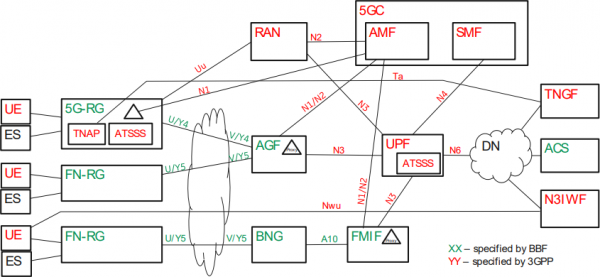Articles
What is new in the TR-181 Device 2.14 Data Model for TR-069 and USP?
5 min read
Parental controls, managed 5G fixed wireless, and new broadband speed tests in TR-181
Hold on, what's a data model?
Data modeling is a way to describe the aspects of a piece of software using standardized elements. For Broadband Forum TR-069 and USP/TR-369, it refers to the elements defined in TR-181 and its related documents, which describe how to model home gateways, smart home devices, and more.
You can learn more about how to navigate BBF data models in our training guide.
The data model that defines what can be managed, monitored, and manipulated by TR-069, and its successor, USP/TR-369, is frequently updated to include new capabilities and interfaces to enable service provider control of the home network. As new technologies emerge, Broadband Forum members contribute to the next version of TR-181 in a fairly fast revision cycle.
The Broadband Forum (BBF) released version 14 of the Device:2 data model for CWMP(TR-069) Endpoints and USP Agents in December of 2020. You can find a “diff” of the updates here for USP and here for the TR-069 version.
Here’s a quick overview of the new features and how to use them.
LAN device time-based access-control - i.e., parental controls
“Parental controls” have become an essential feature for Wi-Fi routers to implement. Manufacturers are using it as an advanced feature to differentiate their products, and service providers are offering it as a value-add to their overall packages.
Naturally, it is useful to be able to control and manage this feature with TR-069 or USP. Device:2.14 adds support for time-based access-control per LAN device, which lets the end-user manage what times a host can access the network and how long that access applies.
This time based control is managed via a schedule object that can be found under Device.Hosts.AccessControl..
Wireline/Wireless convergence for 5G fixed gateways
The BBF Wireline/Wirelesss Convergence group published an architecture specification (TR-470) in August 2020 that provides guidelines for home gateways that include 5G interfaces, either as their primary connectivity interface or as a fallback mechanism. This spec defines how to unify and coordinate traditional broadband edge onboarding mechanisms (e.g., using PPPoE and registering with the rest of the ISP service infrastructure) with the equivalent mechanisms defined by 3GPP for 5G.

Architectural overview of WWC showing different functions (from TR-470)
With the objects included in TR-181, the management of 5G fixed wireless gateways can be handled by the ISP TR-069 Autoconfiguration Server (ACS) or by a USP/TR-369 Controller. These objects include:
- Device.WWC. - This is the base object for Wireline/Wireless Convergence. It has parameters for capability discovery and sub-objects for managing each access network that the 5G Remote Gateway (5G-RG) has connected to. It also has sub-objects for managing traffic descriptors and network slices that can be used by PDU Sessions.
- Device.PDU. - The 5G architecture defines the use of Packet Data Unit (PDU) Sessions, which allow different traffic to flow over different “network slices”. This object has additional sub-objects for QoS and policy rules.
- Device.FWE. - This object acts as the link-layer interface to be used in the device’s interface stack. The Device.Cellular. interface was also updated to include options for 5G.
These objects for 5G fixed gateways come at a time when more and more service providers are exploring 5G as a mechanism for providing last-mile connectivity. Requirements for building 5G-RGs were also added to the BBF’s TR-124 document in Issue 6, so you can use them as a guideline for building your devices!
IP-layer capacity measurement - a better speed test?
Measuring broadband performance is a hot and contentious topic these days, as both consumers and regulators put pressure on service providers to deliver on SLAs. While service quality has to do with a lot more than just raw throughput, it is nonetheless a metric that is in-demand by most of the industry.
TR-143 defines some mechanisms already for broadband speed tests, but the newer BBF TR-471, “Maximum IP-Layer Capacity Metric, Related Metrics, and Measurements” defines a UDP based speed test with some ramp-up and statistical mathematics to make maximum throughput measurement more accurate. It even has an open-source project associated with it for use as reference code (you can find it on Github as ob-udpst here).
Device:2.14 adds the objects and commands to control these new tests using TR-069 or USP/TR-369. You can find them under Device.IP.Diagnostics. (the IPLayerCapacity object in CMWP and the IPLayerCapacity() command in USP). Look for an update to TR-143 soon that will include a “Theory of Operations” on how to run the new tests using the data model.
Testing with CDRouter
CDRouter has support for Device:2.14 data model validation as part of the TR-069 and USP extensions. These tests will programmatically walk through a DUT’s supported data model (as specified by profiles) and double check the data type, read/write permissions, and the presence of required objects and parameters.
As active members of the Broadband Forum, QA Cafe stays on top of the latest new technologies added to BBF data models! Contact us to learn more about how CDRouter can help you build better TR-069 and USP enabled products, faster.
Photo by Frederik Lipfert on Unsplash